|
Report from
Europe
EU tropical timber trade weakened before
COVID
lockdown
Having reached the highest level in more than a decade in
October 2019, EU27+UK trade in tropical wood and wood
furniture products slowed in the last two months of the
year, a trend which accelerated in January and February
this year. Contrary to expectations, with the large western
European countries implementing COVID-19 lockdown
measures during the month, EU imports of tropical wood
products picked up again in March this year.
However, the rise in March is almost certain to be
followed by a very large downturn in April and May with
the shutdown of large sections of the European economy.
During March, widespread reports emerged of timber
importers putting existing orders on hold for 30 to 60 days
and refraining from making new orders.
By the end of the month, importers were already
struggling to deal with a build-up of stock that could not
be shifted as manufacturers, retailers and construction sites
went into lockdown. The only question now is just how far
and for how long will trade decline in the months
following March.
Given current uncertainty, the market position reported
here cannot be taken as providing any real insight into
future trends. Instead, it is better viewed as a picture of the
baseline to measure the size of the expected fall when it
inevitably comes.
Chart 1 shows twelve monthly rolling total US$ value of
imports (to iron out seasonal fluctuations) from tropical
countries into the EU27+UK of all wood and wood
furniture products listed in HS Chapters 44 and 94
(excluding fuelwood, wood waste and chips).
After hitting a high of US$4.64 billion in October 2019,
the 12-month rolling total fell to US$4.45 billion in
February this year, a level maintained into March.
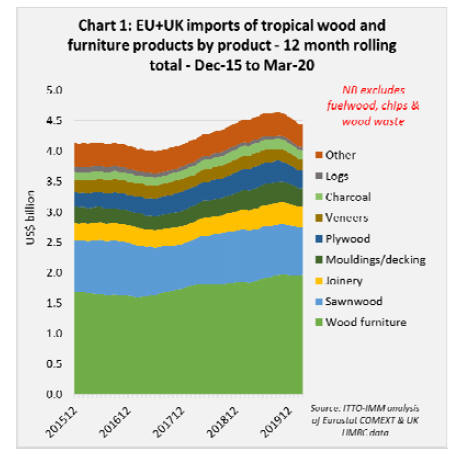
Chart 2 shows that the trend in import tonnage closely
matches the US$ value trend (implying it is not only due
to exchange-rate fluctuation). The 12-month rolling total
quantity of EU27+UK tropical wood and wood furniture
imports increased to a peak of 2.77 million tonnes in
August 2019 before slipping back to 2.60 million tonnes in
February this year, a level maintained into March.
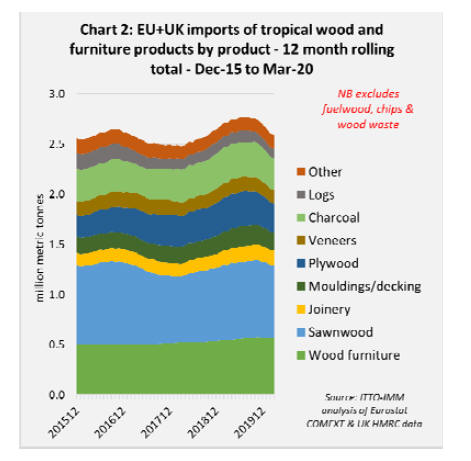
The decline in European imports in the last quarter of
2019 and first two months of this year of course predates
any COVID-19 influence and coincides with a period of
broader slowdown in the EU economy. Both the eurozone
and the EU27+UK grew only 0.1 percent during the last
three months of 2019 compared with the previous quarter,
according to official statistics, the EU¡¯s worst performance
since the beginning of 2013.
All of Europe¡¯s largest economies deteriorated at the end
of last year, Germany and the UK recording flat growth,
and Italy and France seeing a 0.3% and 0.1% contraction,
respectively.
Various factors contributed including continued Brexit
uncertainty, slumping global trade, which hit European
exports, widespread strikes in France over President
Macron¡¯s pension reforms, and weaker domestic demand
for goods and services in Italy, alongside continuing
political difficulties. During this period, the euro also
continued to weaken against the US dollar, eroding the
purchasing power of European importers.
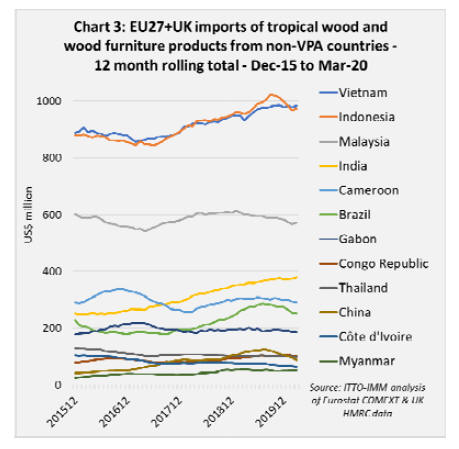
Considering EU27+UK imports of tropical wood and
wood furniture from individual tropical countries key
trends in the period just prior to the onset of COVID-19
pandemic (in declining order of significance in total EU
trade ¨C see Chart 3) include:
Imports from Vietnam, which were flat in 2016 and 2017,
increased consistently throughout 2018 and in the first
nine months of 2019, before levelling off in the last
quarter of 2019 and first quarter of this year. While
EU27+UK imports from Vietnam continue to be
dominated by wood furniture (HS 94), more recently there
has also been growth in imports of a range of other wood
products in HS Chapter 44, notably charcoal and other
energy wood, plywood, laminated wood, planed
sawnwood, and doors.
Imports of wood furniture from Indonesia made large
gains in the second and third quarter of 2019 and
maintained the high level through to the end of March
2020. In contrast to furniture, EU27+UK imports of
plywood, wooden doors, and mouldings/decking from
Indonesia slowed dramatically in the second half of 2019
after strong growth during the previous two years.
Imports of wood furniture from Malaysia also
strengthened in the 12 months to March 2020, but at
slower pace than for Indonesia and Vietnam. However, the
gains made by Malaysian furniture were offset by a
significant decline in EU27+UK imports of Malaysian
sawnwood and plywood. Malaysia was losing ground to
both Cameroon and Brazil in the EU27+UK market for
tropical sawnwood, and to China, Indonesia and Russia in
the market for hardwood plywood.
Imports from India were rising without interruption in the
period before the onset of the COVID pandemic in
Europe, hitting an all-time high of US$379 million in the
year to March 2020. Import growth has been continuous in
Germany, now the largest EU destination for Indian
products.
Imports from India mainly consist of wood furniture made
from local plantation species such as mango, sheesham,
acacia and rubberwood, often in rustic styles which are
hand-crafted.
EU27+UK wood imports from Cameroon, mainly
sawnwood destined for Belgium, continued their
rollercoaster ride, the volatility brought on by supply side
problems, notably shipment delays caused by bureaucratic
red tape and poor infra-structure after many years with
little or no investment at Douala, the country¡¯s only major
port. Between March 2018 and June 2019, imports from
Cameroon were rising, but then declined for the next nine
months to end March 2020.
EU imports of tropical wood products from Brazil,
comprising mainly of sawnwood and decking destined for
France, Belgium and the Netherlands, increased strongly
to a peak of US$286 million in the year ending August
2019 before falling back to US$251 million in the year
ending March 2020. Slow growth in the domestic
economy and the weak currency have encouraged exports
from Brazil in recent years.
However, EU27+UK imports began to weaken from the
middle of last year in response to Europe¡¯s slowing
economy and to tougher EUTR requirements imposed on
operators to demonstrate negligible risk of illegal harvest
for products originating in the Brazilian Amazon.
EU27+UK imports from Gabon were very volatile on a
monthly basis during 2019 and first quarter of 2020, but
overall, on an annual basis, were flat at around US$190
million. Imports into the EU from Gabon comprise mainly
veneer, mostly rotary veneer used to manufacture plywood
in France; sawnwood, much imported via Belgium; and
plywood, which goes mainly to the Netherlands and Italy.
EU27+UK imports of decking/mouldings from Gabon are
still low but have been strengthening.
EU27+UK imports from the Republic of Congo (RoC),
comprising sawnwood, logs and veneers, which were
rising consistently throughout 2018 and 2019, were easing
back in the first quarter of 2020 even before the onset of
the COVID pandemic. Much of the recent growth in
European trade with RoC has comprised logs and
sawnwood destined for Belgium and veneers destined for
France.
EU27+UK imports of timber products from Thailand
consist primarily of furniture, with smaller quantities of
plywood, fibreboard, and charcoal. The main European
destinations are the UK, Germany and France.
Total EU imports from Thailand were stable at an annual
level of just over US$100 million between June 2017 and
January 2020 but showed signs of slowing in February this
year even before the full effects of the pandemic became
apparent.
There was uninterrupted increase in EU27+UK imports of
plywood with a tropical hardwood face from China
between January 2017 and September last year, with US$
value rising from US$50 million to over US$120 million
during this period.
However, with a sharp deterioration in the European
market for plywood at the end of last year, imports had
fallen back to only US$88 million in the year to March
2020. Around two thirds of all EU27+UK imports of
Chinese tropical hardwood faced plywood are destined for
the UK.
After a period of stability in 2018 and the first half of
2019, the long-term decline in EU27+UK imports from
Côte d'Ivoire resumed in the second half of 2019 and
continued into the first quarter of 2020.
The recent decline has been particularly pronounced for
veneers into Italy and Spain, and sawnwood into Belgium
and the UK.
EU27+UK imports of wood products from Myanmar, after
rising from US$35 million in 2017 to US$53 million in
2018, remained at this higher level throughout 2019 and
the first quarter of 2020. Imports from Myanmar comprise
mainly sawnwood with smaller volumes of
mouldings/decking and veneer.
Imports from Myanmar have continued despite high
profile EUTR prosecutions of importers of Myanmar teak
(in Sweden and the Netherlands) and the conclusions of
the EC¡¯s FLEGT-EUTR expert group (most recently
reiterated at their 12 December 2019 meeting) that ¡°it is
not possible to come to a negligible risk of illegally
harvested timber from [Myanmar], in particular due to a
lack of sufficient access to the applicable legislation and
documentation from governmental sources¡±.
While imports from Myanmar into Germany, Belgium and
the Netherlands fell to negligible levels in 2019, these
declines were more than offset by a big rise in imports by
Italy, Greece and Croatia.
Overall shift to value-added products in EU 27 +UK
tropical imports
Overall, the biggest gains in EU27+UK tropical timber
product trade in the year to March 2020 are all in the wood
furniture sector, from Indonesia, Viet Nam, Malaysia and
India (Chart 4). Many of the other large gains during this
period were made in value-added product groups such as
marquetry, kitchenware, and joinery products.
Sawnwood from Ecuador also appears in the list of largest
gainers, probably balsa wood, an assumption made more
likely by the fact that most of the increase was destined for
Denmark and Germany, large manufacturers of wind
turbine blades for which balsa is a key raw material.
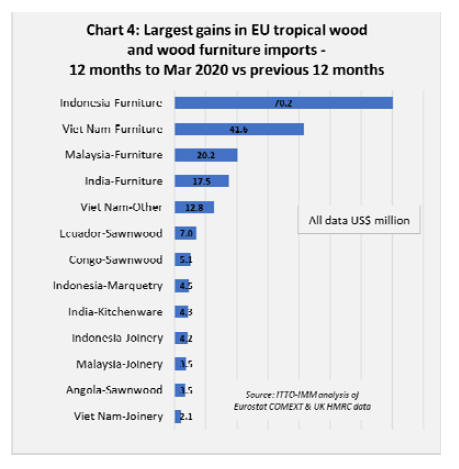
There is more evidence that the European tropical timber
trade in the period just prior to the COVID pandemic was
shifting towards more value-added products in the list of
the largest losers (Chart 5). The biggest declines in
EU27+UK imports in the 12 months to March 2020 were
almost exclusively in more traditional secondary
processed products such as sawnwood, plywood, and
mouldings/decking.
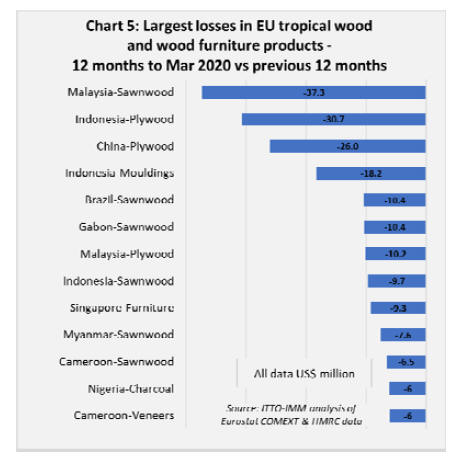
No pandemic impact in March trade data
The lack of any strong COVID signal in the tropical
timber trade data to the end of March is more obvious
from the monthly data. The period of COVID-19
lockdown in Europe began in Italy with an emergency
decree on 9th March covering the Lombardy region,
Italy¡¯s financial and industrial powerhouse. The Spanish
government followed with a general confinement order for
most of the country from 14th March. Then came
lockdowns in France (17th March), Belgium (18th March),
and the UK (23rd March).
The German Federal government did not implement a
nationwide lockdown in response to Covid-19, but during
March state governments across the country progressively
tightened restrictions on movement, prohibiting large
gatherings, calling on people to stay at home, and asking
that they observe other social distancing measures in an
effort to stop spread of the virus. However, the German
government also stressed the need to keep key sectors of
the national economy functioning and issued a decree
allowing construction activity to continue.
The Netherlands also stopped short of a complete
lockdown. Instead, in a series of measures issued on 12
March, the Dutch government asked that people stay at
home as much as possible, banned gatherings except those
¡°necessary to ensure the continued daily operations of
institutions, businesses and other organisations¡±, and
encouraged other social distancing measures.
In March and April, according to a report by Bollore
Logistics, European ports continued to operate despite
difficult conditions and containers were being processed
for onward movement, although clearances by some
customs authorities was slower and there were border
bottlenecks. Most shipping companies continued to
operate, although they were adding surcharges and
available space and equipment had become very restricted.
Chart 6 highlights that while EU27+UK monthly trade
was highly volatile in the last quarter of 2019 and first
quarter of this year, trade in March was significantly
stronger than in February, and not noticeably slower than
the same month in the previous year. Imports from
Indonesia were particularly strong in March this year, at
US$96 million, the third best monthly import performance
from Indonesia in the last 5 years.
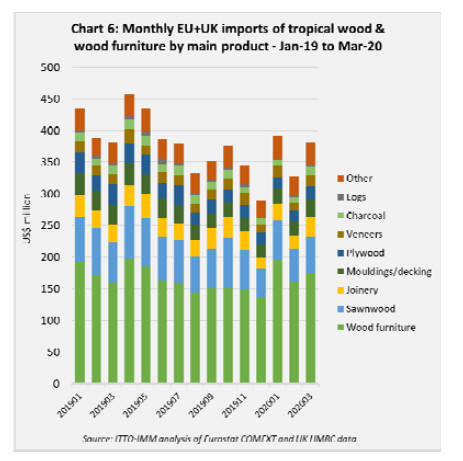
Chart 7 shows that EU27+UK imports of all tropical wood
and wood furniture products were higher in March than in
February this year.
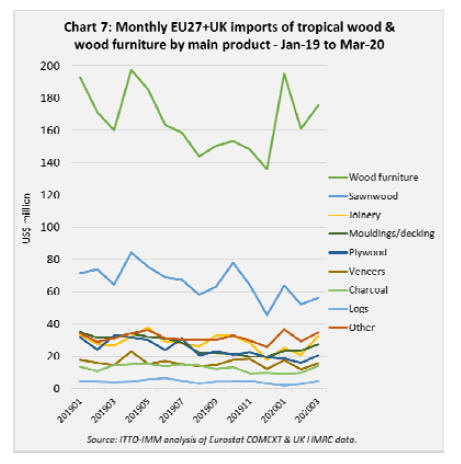
Chart 8 highlights that in March 2020, EU27+UK imports
of tropical wood and wood products from Indonesia and
India were particularly strong, while imports from most
other countries, with the possible exception of Vietnam,
were yet to show any signs of weakness brought on by the
COVID lockdown measures.
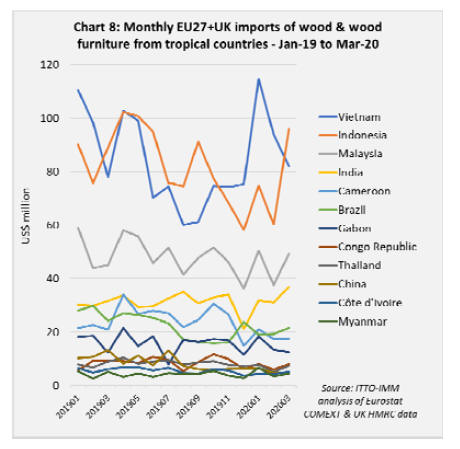
Chart 9 shows that nearly all the major European markets
imported more tropical wood and wood furniture products
in March this year compared to the previous month.
France was the only significant market to record a
decrease, but this followed a strong rise in imports in
February.
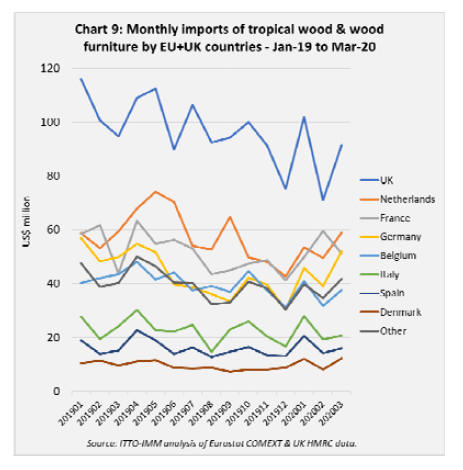
It would be wrong to read too much into this trade data
which only captures the very beginning of the lockdown
period. Indices of economic activity in the EU27+UK
plunged in April and were only recovering slowly in May
as the lockdown was eased in most European countries.
On 6th May, the EC predicted a decline in EU economic
activity this year of 7.5%, and slightly more than that for
the eurozone. The EC also warned the outcome could be
worse if the pandemic turns out to be longer or more
severe than currently envisaged.
The EC report outlines sharp falls in hard-hit countries
such as Italy, Spain and France ¡ª all of which will see
their GDP drop by more than 8% this year. In Greece and
Spain, the fall is forecast to be well over 9%. Even in
Germany, which has won praise for its handling of the
coronavirus crisis, the downturn is expected to 6.5% in
2020.
According to European Commissioner for the Economy,
Paolo Gentiloni, "in 2021 we expect a rebound of 6.1% in
the EU and 6.3% in the euro area ¡ª not enough to fully
make up for this year's loss". UK GDP growth this year.
On 7th May, the Bank of England forecast that UK GDP
would fall 14% this year and tentatively predicted a 15%
rebound next year if coronavirus restrictions can be lifted
without a causing a second wave of the virus.
|